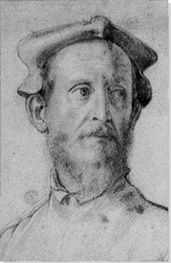Summary of Jacopo da Pontormo
Pontormo was one of the most radical individuals in the history of Italian Renaissance art. Recognized primarily as a religious painter, he received widespread praise too for a number of perceptive portraits. Rubbing shoulders with some of the great masters of the High Renaissance, including his friend Michelangelo, Pontormo (unlike his esteemed compatriots) looked towards the art of northern Europe where he found inspiration in the engravings and woodcuts of German and Dutch art. The hallmarks of his mature Mannerist style were evident in the spiritual, rather than physical, presence of his figures; in his vivid use of color; his fluid contoured lines; and in his ambiguous approach to pictorial space. During the last decade of his life Pontormo became increasingly reclusive and troubled, leading him to refuse the company even of the great Bronzino, who had been like an adopted son to him.
Accomplishments
- Pontormo's early work demonstrates his mastery of the principles of control and compositional distribution that characterized the Renaissance style. Yet even early on, when Pontormo carried forward the chiaroscuro and sfumato effects he took from his early master Leonardo da Vinci, Pontormo's elongated "floating" figures hinted at a new dawning for Italian art that would see it move towards a less naturalistic, more expressive, style.
- Leaving behind the compositional disciplines of his former masters, Pontormo introduced a rhythmic quality to Italian art that took its influence from Northern Europe and specifically Albrecht Dürer's woodcuts and Lucas van Leyden's engravings. The advance towards a full Mannerist style was further enhanced by Pontormo's refusal to situate his figures in naturalistic settings. His swirling, serpentine, figures occupy the whole of his frame bringing a heighted psychological aspect to his painting.
- In addition to his religious paintings, Pontormo proved a highly accomplished and adept portraitist. His sophisticated depictions, most notably those he made for Florence's ruling Medici dynasty, are packed with subtle departures from the current "heroic" conventions for portraiture. His sitters possess a rare psychological dignity that is enhanced by the artist's fine eye for symbolism (which, in the case of the Medici's, alluded to their political and economic power).
- Pontormo's mature works were brought to life by his crisp, sumptuous, palette which served to give drapery and clothing a vibrancy all of their own. His non-naturalistic style also extended to his ensemble of twisting elongated figures none of whom seemed tethered by the rules of gravity. This later Mannerist phase is seen as the forebearer of the Baroque period.
The Life of Jacopo da Pontormo
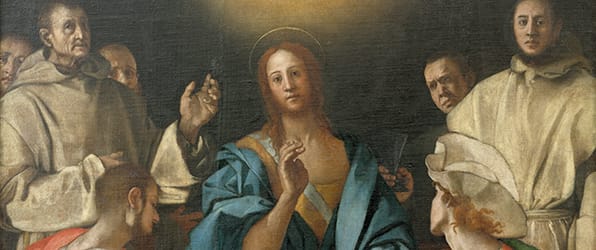
Italian High Renaissance painter, and lonely orphan, Jacopo da Pontormo, who was a student of da Vinci and friend of Michelangelo, departed from his contemporaries by moving toward the Mannerist style, and looking to the artists of the European North for inspiration.
Important Art by Jacopo da Pontormo
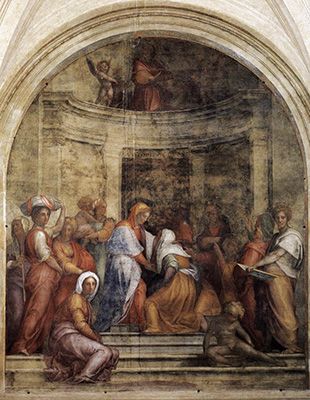
Visitation of the Virgin and St. Elizabeth
Typical of Visitation scenes, this work shows the moment when St. Elizabeth (pregnant with John the Baptist) visits the Virgin Mary (pregnant with Jesus) thus symbolizing the future importance of the relationship between the two unborn children. This early painting is in fact one of two Visitation scenes Pontormo painted, the second completed a little over a decade later. Comparison between the two works demonstrate the significant shift made by Pontormo from Renaissance modes of representation toward Mannerism.
In this earlier version we see the influence of Pontormo's master Andrea del Sarto, in the solidity of the figures, the simplicity of their gestures, and the variety of poses. Pontormo also follows the Roman-Catholic Renaissance tradition of depicting Elizabeth bowing in reverence to Mary (as is also seen in earlier Visitations, such as that painted by Domenico Ghirlandaio in 1491, and that sculpted by Lucca della Robbia around 1440).
Pontormo's earlier Visitation also demonstrates adherence to other principles of Renaissance painting. For instance, the figures stand at just under half the height of the painting, in a classicized architectural setting. Art historian Jack Wasserman notes that this backdrop "endows the painting with monumentality, controls the distribution of the figures, and leads the eye of the beholder from the meeting of Mary and Elizabeth upward to the Sacrifice of Abraham [represented in the inscription in the top of the architecture]". However, even at this early stage in his career, Pontormo is already beginning to break away from tradition and develop his own style. This is most evident in the elongated, seemingly weightless figures, their more serpentine poses, and the haunted expressions they wear, as well as the crowding of the composition with figures.
Fresco - Basilica della Santissima Annunziata, Florence
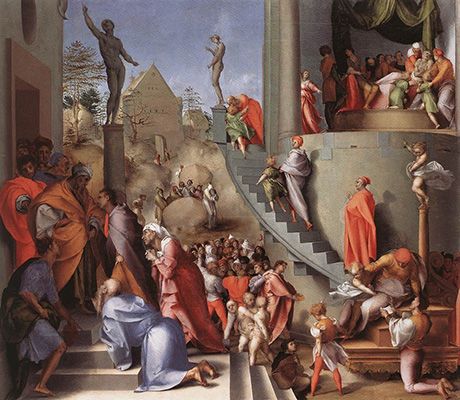
Joseph in Egypt
This painting depicts the biblical episode in which Joseph reunites with his family. It is one of a series of fourteen paintings (by Pontormo, as well as Andrea del Sarto, Francesco Granacci, Bachiacca and Franciabigio) that trace the life of Joseph, painted for prominent Florentine banker and patron Pier Francesco Borgherini to commemorate his 1515 marriage to Margherita Accaiuoli.
The series was originally set into the wall paneling and furniture in the couple's bedroom at the Borgherini palace in Florence. As art historian Allan Braham notes, the story of Joseph was selected as the central theme, as it "bears upon material and spiritual success [...] the subjects of chastity and dreaming, and one that has a deeply moral purpose insofar as the life of Joseph is shown as a pre-figuration of the life of Christ".
Here, Pontormo continues to challenge the High Renaissance artistic principles of calmness and balance, by using vivid colours, and by creating a striking, restless, asymmetrical composition, in which not only the figures themselves adopt serpentine poses, but also their placement within the scene - creating a sort of S-shape for the eye to follow. Pontormo thus makes, as art historian Frederick Mortimer Clapp asserts, "a rather self-conscious effort to escape from old formulas by distributing his figures and arranging them in little groups, on planes that are defined by the various parts of an architectural setting".
Pontormo's complex composition presents several separate scenes simultaneously: 1) Joseph presenting his family to the pharaoh (left foreground), 2) Joseph sitting on a triumphal cart pulled by three putti, leaning down to hear a petition (right foreground), 3) Joesph leading one of his children by the hand up the staircase toward his mother who embraces his other child at the top of the stairs (center), and 4) Joseph presenting his children (Ephraim and Manasseh) to be blessed by his dying father, Jacob (top right).
The influence of Northern European painting can be seen here in the clothing, the expressions and features of the figures, as well as in the style of the castle and trees in the background. Pontormo drew heavily from Dutch painter and printmaker Lucas van Leyden in designing the landscape, in particular, Leyden's 1510 engraving Christ Presented to the People. This setting was later adopted by Salviatti for his fresco of Bathsheba and David, painted in Rome's Palazzo Sachetti in the 1560s.
Oil on panel - The National Gallery, London
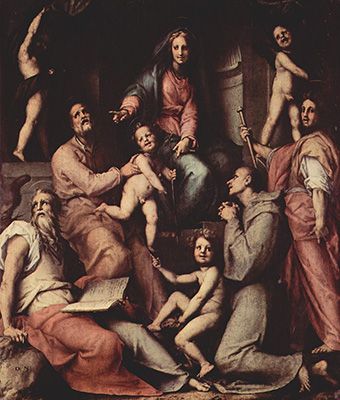
Madonna with Child and Saints
This painting, commonly referred to as the Pucci Altarpiece (as it was commissioned by Francesco Pucci, a political figure who worked with the Medici family), is Pontormo's largest oil painting, and one of the few works by him which still resides in its original location. It was highly praised at the time of its creation, with Vasari referring to it as "the most beautiful panel ever made by this extremely rare painter".
The painting depicts the Virgin Mary, positioned above St. Joseph who is holding the baby Jesus, and surrounded by (among others), Saints John, Francis, and James (the latter representing a self-portrait by Pontormo) who look on in admiration. Instead of depicting Mary holding Jesus, as was the convention, Pontormo's decision to place the baby in Joseph's hands emphasizes his role as an adoptive paternal figure, and reflects a general rising interest in Joseph, and his role in the Holy Family, during the sixteenth century.
The use of chiaroscuro and sfumato shows Da Vinci's influence, as do the mysterious smiles of the figures and the poses of the Christ child and little St. John. On the other hand, the composition departs from the harmony and balance favored by Pontormo's former masters, and demonstrates rather an attempt to experiment with a novel sort of rhythm, inspired in part by Dürer's woodcuts of the Passion. Likewise, the painting shows further progression toward Mannerism by removing the figures from any sort of recognizable or naturalistic setting, instead placing them in a void, psychological space that lacks perspective. Here, the figures take up the entire frame, adding to the sense of suffocation, compression, and agitation created by the swirling composition and twisting body positions.
Oil on panel - San Michele Visdomini, Florence
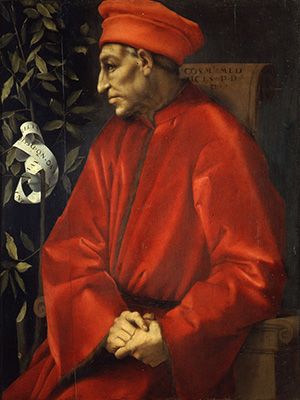
Portrait of Cosimo di Giovanni de' Medici il Vecchio
In 1512, following 18 years of political exile, the Medici family was welcomed back to govern Florence. Cosimo (who died in 1464) was once considered a wise and learned Florentine patriarch and the new Medici government saw an opportunity to present Cosimo as a dynastic symbol of a family that would restore prosperity and peace to the city. Executed more than fifty years after his death, Pontormo's painting was based on nothing more than a medal cast shortly after Cosimo's passing. Yet from this single source, Pontormo succeeded in communicating the patriarch's wisdom and stateliness.
The stately red robe lined with fur was typical of republican Florentine citizens who were qualified to hold office. The three-quarter-length format, uncharacteristic of private family portraiture at the time, was strategically selected to recall the 1476 portrait of scholar Vittorino de Feltre by Justus of Ghent, as well as the 1511 portrait of pope Julius II by Raphael. Allusion to these portraits would have strengthened the idea of Cosimo as a sagacious and saintly elder. His pose also recalls common depictions of the figure of Florentia, symbolizing him as the embodiment of Florence.
To the left side of the painting stands a laurel tree around which is knotted a white banderole (another atypical feature for portraiture from this period). The text on the banderole appears upside-down, indicating that it is intended to be read by Cosimo rather than the viewer. The text, adopted from the Aeneid, reads "Nunc Avulso non Deficit Alter," which translates as 'When one is torn away, the next will not falter". Yet, as art historian Mary Hogan Camp notes, "Though the portrait is clearly encomiastic and reinforces the idea of the inevitability of Medici rule, a quiet undercurrent of reserve and doubt, injected by the artist, can be detected in the elements of design". For instance, the aging banker's finely modelled hands appear, as Clapp writes, "tightly clasped before him for fear some violent animation in them betray his stealthy calm".
Oil on panel - The Uffizi Gallery, Florence
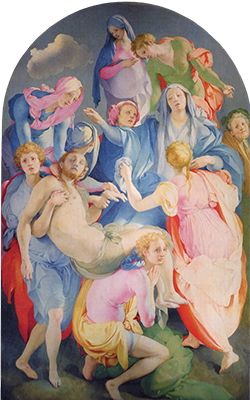
The Deposition from the Cross
In this masterpiece, we see Pontormo's Mannerist style fully realized. Here he adopts vibrant, saturated hues to illuminate figures in serpentine poses. His characters are removed from any sort of naturalistic setting, being placed rather within a shallow, flattened space. Pontormo has also removed the cross from the scene, instead merely suggesting its form through the arrangement of the figures. The focuses here then is on the dramatic emotions of the scene rather than one more Deposition narrative. Gone too are other markers of reality, such as blood, dirt, or the crown of thorns. The only indication of Christ's death is the slight grey pallor that affects his skin, noticeable in contrast with the clear, crisp colors used in the rest of the work. This palette was most likely inspired by that used by Michelangelo for the ceiling of the Sistine chapel. Likewise, Christ's twisting body recalls Michelangelo's 1498 Vatican Pietà.
The whirling, twisting composition of elongated figures creates a confusing mass, possibly alluding to the complexity of life. The figures appear unbound by the laws of gravity, and the feet of the two figures carrying Jesus seem to barely touch the ground. These figures have been interpreted by many as angels, carrying Christ to heaven. The single, small white cloud at the top left is commonly understood as representing the presence of the Holy Spirit (replacing a ladder included in a preparatory drawing, which would have carried the same association but functioned less harmoniously in the image due to its solid, straight form).
The overwhelming sense of loss and anguish of the figures is strongly conveyed in their expressions, and is strengthened by the absence of any figure at the center of the composition, where instead, the hands of several of the figures come together, as do the legs of Mary and Jesus. This space has commonly been understood as representing Mary's sense of emptiness upon losing her son. The figure at the right edge, whose drab, earthy-colored clothing, makes him seem out of place, is a self-portrait by Pontormo, a single earthly being bearing witness to this spiritual scene.
Oil on wood - Church of Santa Felicita, Florence
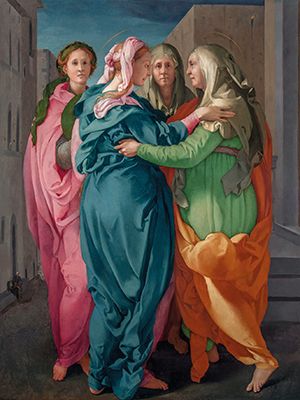
The (Carmignano) Visitation
In this, the second of two Visitation scenes painted by Pontormo, we see an interesting Mannerist reinterpretation of his earlier much work. Here, Pontormo disposes of the crowd of people, instead bringing the viewer up close to the intimate meeting of the two pregnant women who almost entirely fill the frame, situating the in-utero Jesus and John at the centre of the image.
Unlike Pontormo's earlier Visitation, in which Elizabeth bows to Mary Pontormo now paints Mary and Elizabeth embracing as equals, standing at the same height as one another. This compositional choice indicates sympathy with the Lutheran (Protestant) ideals that were spreading throughout Europe at the time. Standing immediately behind the embracing protagonists are a second Mary and Elizabeth pairing who gaze directly toward the viewer with haunted expressions. These two companions thus implicate the viewer further into the intimate scene, using eye contact to force the viewer to adopt a more active role. Furthermore, the companions appear to be idealized doubles, with Elizabeth's double in particular appearing more youthful suggesting perhaps that they are spiritual companions.
Other Mannerist trademarks are visible in this painting, such as the crisp, brilliant colors of the figures' billowing drapery, and the serpentine positions of the foremost Mary and Elizabeth. Mannerist in nature too is the distorted perspective and the ambiguous setting, in which only a hint of urban architecture is visible.
Oil on panel - Santi Michele e Francesco, Carmignano, Italy
Biography of Jacopo da Pontormo
Childhood
Jacopo Carucci (later known as Jacopo da Pontormo) was born in Pontorme, near Empoli, in Tuscany to the painter Bartolomeo di Jacopo di Martino Carrucci and his wife Alessandra di Pasquale di Zanobi. He is known to have had one sister. Pontormo was orphaned at a young age, losing his father, mother, and grandfather in rapid succession. Having already been raised to appreciate the values of the High Renaissance by his father, Pontormo came into the care of his grandmother Mona Brigida who educated the boy in reading, writing, and rudimentary Latin. At the age of nine, he was taken to Florence and placed in the care of a distant relative by the name of Battista. Given these early upheavals, it is little surprise that Pontormo's contemporary, the art historian Giorgio Vasari, described Pontormo as a "young, melancholy and lonely" boy.
Education and Early Training
At the age of eighteen, Pontormo was apprenticed to Leonardo da Vinci, and then to Mariotto Albertinelli and Piero di Cosimo, before, in 1512, he came under the tutorship of Andrea del Sarto. None of his apprenticeships lasted very long, most likely due to Pontormo's "difficult" personality. Indeed, having gained such an eclectic range of influences in such a short time, and being quite naturally gifted and creative, Pontormo was often the object of ridicule amongst his less talented, less audacious, fellow apprentices. However, it is believed (although unconfirmed) that around 1511, Pontormo took a brief trip to Rome with a fellow apprentice of del Sarto, Rosso Fiorentino, in order to undertake a close study of Michelangelo's works at the Sistine chapel.
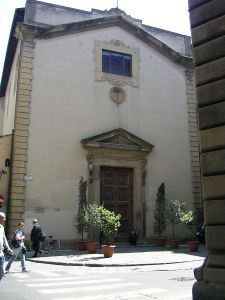
The influence of Da Vinci and del Sarto are most evident in Pontormo's early works, notably the altarpiece in the Church of San Michele Visdomini, Florence, completed in 1518. At the same time, however, Pontormo's early works (such as the San Michele altarpiece, as well as the series titled Joseph in Egypt, also completed around 1518), were already exhibiting an individual style that moved away from the serene balance that had come to define High Renaissance painting. Pontormo's painting was already starting to show a more energetic and restless style. His work featured elongated and floating figures, ornamentation, distorted perspective, a focus on emotion and the psyche, and a preference for more vivid coloring. These features were to become the hallmarks of Mannerism. In addition to religious paintings, Pontormo also began executing portraits around this time.
Mature Period
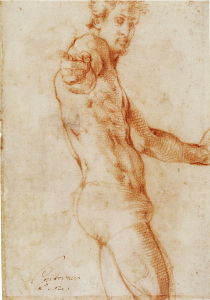
Around 1517, Pontormo had taken on a pupil, Bronzino, who, having adopted his master's style, developed into one of the greatest Mannerist painters. Student and master would develop a lifelong friendship with Vasari reporting that "so great were the patience and lovingness of [Bronzino] towards Pontormo, that [Pontormo] was forced always to look kindly upon him, and to love him as a son" (Vasari even tells us that Pontormo included Bronzino in his series on Joseph in Egypt, depicting young Bronzino as a child seated on a step in the foreground). Bronzino accompanied and assisted Pontormo with commissions wherever he went, until about 1527.
In 1521, Pontormo was hired by the Medici family to decorate their villa at Poggio a Caiano with mythological paintings, and he would receive a number of other important commissions from the Medici in the following years.
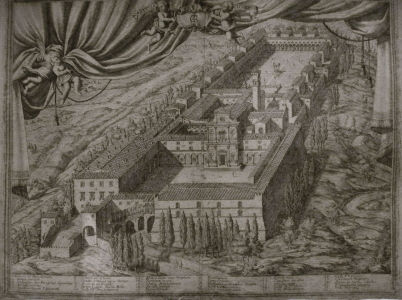
In 1522, Pontormo and Bronzino entered the Certosa di Galluzzo, a Carthusian monastery just outside of Florence, in order to escape the outbreak of the plague (although the introverted Pontormo no doubt took to a tranquil setting in which monks followed a vow of silence). For the next three years, Pontormo (and his young partner) worked at the Certosa on a series of frescoes - The Passion Cycle - for which he drew inspiration from the woodcuts and engravings he had seen in the work of the German artist Albrecht Dürer. Writing about The Passion Cycle, art historian Frederick Mortimer Clapp observed that, "Suddenly we are witnesses of the curious spectacle of an Italian painter of great attainments seeking to escape from the tyranny of Michelangelo's canon of form by flying to that of Dürer. This choice, the strangest that an Italian ever made, was for [Pontormo] the craving of an instinct, and quite apart from his strangely modern susceptibility to novelty, he was, we may believe, swayed by an intimate compulsion, for there was in Dürer's designs an intense metaphysical quality that Pontormo was born to understand".
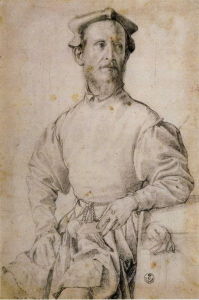
Pontormo seems to have solidified his unique Mannerist style soon after returning to Florence, when he painted his masterpiece Entombment (Deposition from the Cross) (1525-28) at the Santa Felicità church. Throughout most of the 1520s, he lived in lodgings at the parish of San Giovanni, and was extremely active in this period. His achievements were formally acknowledged in 1526 when he was enrolled into the Guild of the Medici e Speziali. By 1529, Pontormo had the means to purchase two lots on the Via Laura (now the Via della Colonna), where, five years later, he finished constructing a small house as well as a second-floor bottega (workshop) accessible only by ladder. He was known to pull up the ladder while he was working, in order avoid the risk of interruption or distraction.
Late Period
After 1530, Pontormo worked almost exclusively on commissions for the Medici family. It was also around this time that he met Michelangelo in Florence and the two developed a personal relationship. Unlike his contemporaries, however, Pontormo was not content to merely emulate the Great Man of Renaissance art. As Clapp argues, "To Pontormo [Michelangelo's] canon, once thoroughly studied, became what all other canons had been to him - the crude material of a new form of decoration". Clapp argues that the late phase of Pontormo's career "proposed nothing less than to use Michelangelo's superhuman giant in a new scheme of mural painting, in which he would audaciously employ that monstrous nude to create a novel and more fantastic beauty".
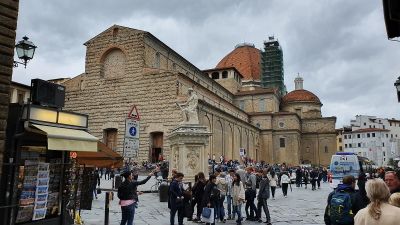
Pontormo devoted the last ten years of his life to painting frescoes of the Last Judgment at the San Lorenzo Basilica in Florence. His pace was slowed by his deteriorating health (which Vasari attributed to overwork), and it would seem that at this point, he was only able to work about half of the days in each month. Although these frescoes were unfortunately destroyed about two centuries later by gradual degradation of natural forces, preparatory drawings survive. These drawings show a dizzying, tangled assemblage of sinuous, serpentine, writhing figures that appeared to float ambiguously in space, sharply contrasting against the Last Judgment painted by Michelangelo in the Sistine Chapel (1536-41), which is characterized by solidity and stability of the figures. Pontormo's composition was especially daring (both pictorially and theologically) in that it placed God at Christ's feet rather than above him.
According to Vasari, Pontormo had always been withdrawn and neurotic, often shutting himself inside his home for weeks on end, refusing to speak to even his close friends (including Bronzino). Although, from 1549 to 1557, he rather unexpectedly took on another pupil, Giovanni Battista Naldini.
According to the journalist James Fenton, in the last two years of his life Pontormo kept a diary in which he obsessed over, "his diet, his deteriorating health, his bowel movements [and] the weather". He also kept a record of his day-to-day accomplishments in their minutiae. Clapp says of the diary that "It has no literary flavour and betrays no preoccupation except that of setting down for himself, and for their own sake, his daily experiences [...] These pages are full of the flavour of solitude, simple living, and arduous labour".
When Pontormo passed away on January 1, 1557, Bronzino took over work on the San Lorenzo frescoes, staying true to Pontormo's plans by following the preparatory drawings he retrieved from his master's estate. After Pontormo's passing, Bronzino assumed he would be heir to Pontormo's estate (he had never married). However, the estate was ultimately awarded to a man who falsely claimed to be Pontormo's relative.
The Legacy of Jacopo da Pontormo
Clapp writes of Pontormo that, "In so solitary a life, to a nature so intense and lonely as his, the training of pupils was impossible. What was best in his art was too personal to be easily imitated, too subtle and too various to become a canon to young artists. On the other hand, no artist, no matter how talented, could have formed a school in Florence at a moment when all art had become Michelangelesque. As far as their influence on others went, Pontormo's rare gifts were largely wasted".
Nevertheless, Pontormo played a significant role in the move away from Renaissance modes of representation toward the Mannerist style. In particular, he moved away from solidity and regularity, and toward the representation of elongated figures in floating, dance-like poses, as well as ambiguous perspective, vibrant colors, and psychological, non-naturalistic environments that appear to defy the laws of gravity. These Mannerist trademarks can be seen in the work of his famous pupil, Bronzino, as well as that of later principle Mannerists like Parmigianino, Giambologna, Granacci, and El Greco.
Pontormo also influenced Southern European artists by drawing inspiration in his works from Northern European artists like Albrecht Dürer. Art historian Allan Braham asserts that "the influence of Pontormo's work, including the use he made of northern art, upon succeeding generations of painters is particularly clear in his approach to architecture". For instance, the setting for Pontormo's Joseph in Egypt (1517-1518) was directly derived from Lucas van Leyden's 1510 engraving Christ Presented to the People, and this setting was then adopted by Salviatti for his frescoes painted in Rome's Palazzo Sachetti in the 1560s.
Pontormo also influenced portrait painting, imbuing his own portrait work with dignity, elegance, repose, and simplicity. He seemed to have a particular talent for grasping the psychology of the sitter. It is thus not surprising that his pupil Bronzino became famous for portrait painting, becoming employed as court painter for the Medici family, who had previously employed Pontormo. Clapp asserts that "It was [Pontormo] who first transformed portraiture by seeing it in terms of Michelangelo's heroic vision and it was [Pontormo] who, in recording the appearance of his sitters, first sought to combine a massive imaginative simplicity and dignity of presentation with an intangible evocation of individual character". Pontormo's "intuitive intelligence" for portraiture went on to find its way "through certain Italians who worked in Spain, and through Flemish artists like Antonio Moro who worked in Italy, into our general tradition of form".
Influences and Connections

-
![Leonardo da Vinci]() Leonardo da Vinci
Leonardo da Vinci -
![Andrea del Sarto]() Andrea del Sarto
Andrea del Sarto -
![Albrecht Dürer]() Albrecht Dürer
Albrecht Dürer - Mariotto Albertinelli
- Piero di Cosimo
-
![Michelangelo]() Michelangelo
Michelangelo -
![Bronzino]() Bronzino
Bronzino - Rosso Fiorentino
-
![El Greco]() El Greco
El Greco -
![Tintoretto]() Tintoretto
Tintoretto -
![Parmigianino]() Parmigianino
Parmigianino - Giovanni Battista Naldini
- Jacopo da Empoli
-
![Michelangelo]() Michelangelo
Michelangelo -
![Bronzino]() Bronzino
Bronzino - Rosso Fiorentino
Useful Resources on Jacopo da Pontormo
- Pontormo's DiaryOur PickBy Rosemary Mayer
- Jacopo Carucci da Pontormo, his Life and WorkOur PickBy Frederick Mortimer Clapp
- Maniera: Pontormo, Bronzino and Medici FlorenceOur PickBy Bastian Eclercy
- Pontormo, Bronzino, and the Medici: The Transformation of the Renaissance Portrait in FlorenceOur PickBy Carl Strehlke and Elizabeth Cropper
- Pontormo and Rosso Fiorentino: Diverging Paths of MannerismOur PickBy Carlo Falciani and Antonio Natali
- PontormoBy Doris Krystof
 Ask The Art Story AI
Ask The Art Story AI